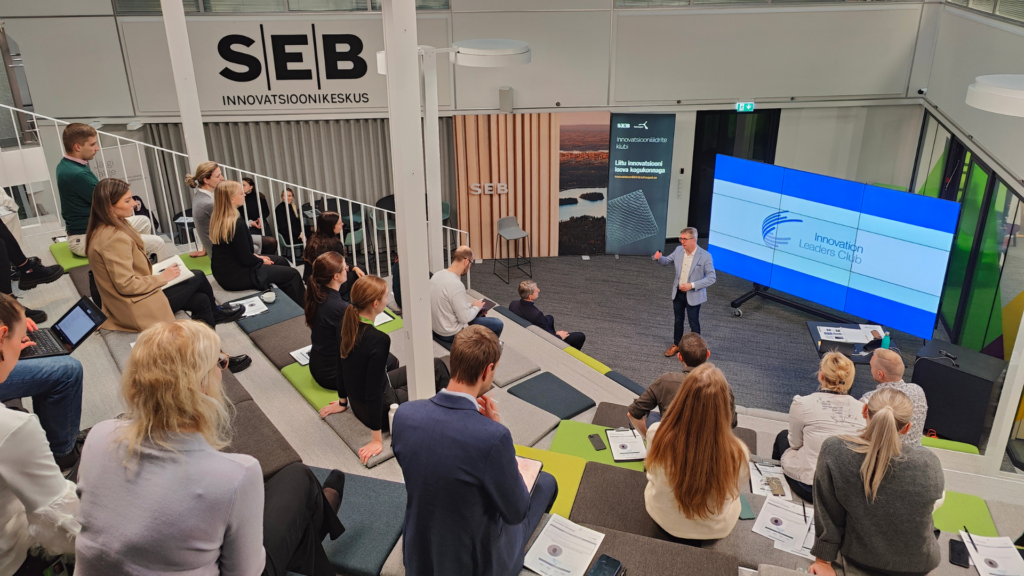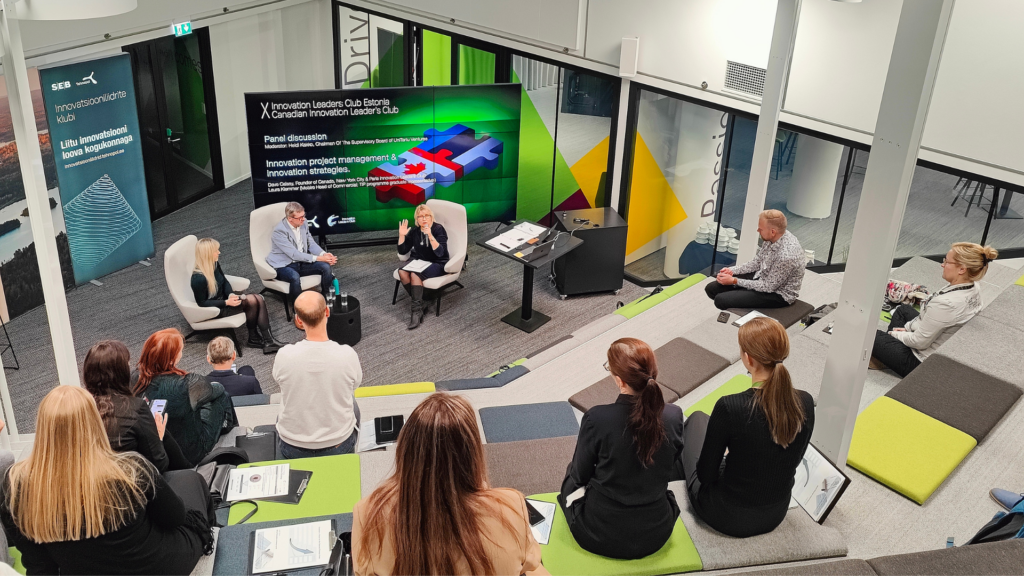06.11.2023
Creating innovation needs a strategic approach – best practices from the Canadian Innovation Leaders Club

The members of the Innovation Leaders Club gathered for the second event of the IV season at the SEB innovation centre, on the 26th of October. The event was organised in collaboration with the Canadian Innovation Leaders Club.
The Canadian club was represented by Dave Caissy, who shared his extensive experience and valuable insights from working with hundreds of companies, helping them grow through innovation. Two intensive workshops were conducted with the participants, to really put the new knowledge into practice. The afternoon concluded with a panel discussion with Heidi Kakko (UniTartu Ventures), Laura Klemmer (Mobire) and Dave Caissy, where innovation project management and innovation strategies were discussed from practical viewpoints.
Caissy led the introduction by giving an overview the Canadian Innovation Leaders Club, which also extends its reach to New York and Paris. The club closely collaborates with numerous organizations, assisting them in scaling their businesses through innovation.
Constant innovation is a challenge
Organisations recognize the need for innovation, but often they lack the appropriate strategy, which is a vital element for innovation development, Caissy stated. He highlighted that innovation is best pursued proactively, rather than reactively – meaning the ability to take initiative towards innovation, rather than reacting to market volatility or the actions of competitors.
Another frequently misunderstood concept for organisations is the time that innovation takes. The more innovative companies innovate year after year, which for another set of organisations might be a true challenge – but that does not make their innovation processes invalid, Caissy assured. “Develop faster” is not the solution, rather innovators need to initiate processes early on. He emphasized that the solution lies in an innovation system. The main part of the system is the innovation strategy, which Caissy introduced in extent throughout the event. “An innovation strategy is to be clear in what we want to do, focus on, and achieve,” he summarized.
An innovation strategy is a critical component for every innovative organization, as it is simple for innovators to lose focus amidst constant generation of ideas and emerging trends. The strategy helps to keep a level head and focus on the set and agreed upon goals for innovation. A major impediment to innovation is the scattered effort of trying to innovate on too many fronts simultaneously, a point Caissy made from his experience. To address this issue, having an established innovation system within the company is crucial.
Focus on the right elements
Innovation does not necessarily have to be the development of a new product or service, rather it is important to offer new value for the client. “In 2023, innovation is not necessarily something you can sell anymore,” Caissy highlighted. He stressed the importance of having a clear vision of where you want to go, which serves as a guiding light throughout the innovation processes. Caissy asked the audience to guess how many novel innovation ideas Apple, one of the most innovative companies, receives on a daily basis. ”They don’t even know, since they don’t care,” Caissy answered humorously, “this is how strong their vision and innovation strategy is.” He was also clear that an innovator needs to know how to say “no” – if it cannot be done, then the innovation strategy is not clear.
Organizations often worry that their lengthy innovation processes might not be perceived as innovative once they finish. Caissy encouraged to focus on the external, not the internal perspective – while internally it might seem as if the innovation process is taking too long, then externally it goes unnoticed as the end client will not sense this timeline – they only sense the value offering.
The processes for innovation need to start early on. Caissy brought an example of one company, which noticed its main product sales declining and rang the figurative fire alarm for the fast-paced need to innovate – only to be already too late. He advised once more that innovation needs to be proactive, and that it needs to start when everything is going well, not when “the fire is burning”.
In order to achieve significant innovation, it is imperative to have a dedicated team. Caissy stated that the core team involved in the innovation processes should be smaller rather than larger, as a larger team often leads to fragmented results. A smaller dedicated team has the ability to truly focus on the vision for innovation and take action accordingly, he emphasized. “The vision needs to be ambitious. If your objective is not motivating people – then you have the wrong one.” He advised having a 3-year innovation program instead of an annual one, as it is a more attractive timeframe for innovation creation for all parties involved.

Innovation management needs to be ambitious
Before proceeding to the second workshop of the day, the specialists engaged in a panel discussion. Laura Klemmer introduced the innovation practices and experiences from Mobire, a company operating in the field of full-service car rentals. Their current innovation program is working on entering the B2C market, which brings along a whole new customer segment. She shared that Mobire has defined strategic areas they want to innovate in, including digitalization, expanding their customer value offering, and acquiring new customer segments – all of their innovation efforts are directed toward these areas.
The panelists elaborated on who should be the leader of innovation within a company. Caissy suggested that appointing a “director of innovation” is often a mistake, as innovation management has different layers. In the most innovative organisations, you do not usually see a specific innovation leader, you see different layers of innovation managers. Klemmer confirmed this by sharing that Mobire had established an “innovation board,” consisting of three people who evaluate the company’s innovation processes.
The panelists further discussed on how proactive – or crazy – a company can actually be about innovation. Caissy suggested that an organization likely will not reach the lengths of Mars, and not even the Moon, but the important thing is to keep aiming that high. As innovation can be incremental or disruptive, how can companies take a bigger leap by creating disruptive innovation? Caissy shared his insight that, in most cases, disruptive innovation is not planned and rather just happens – by taking small steps consistently, it is likely that a disruptive innovation reveals itself within the process. Klemmer added that in order to be an innovator, one does not need to be an inventor, rather it is necessary to look what is happening around and adjust accordingly.












